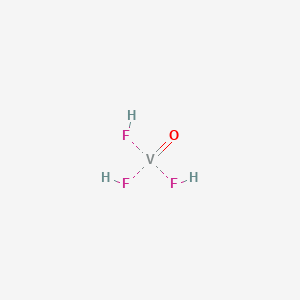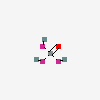Vanadium(V) oxytrifluoride
- 13709-31-4
- Trifluorooxovanadium
- Vanadium oxytrifluoride
- Vanadium(V) trifluoride oxide
- Vanadyl trifluoride
- Create:2005-03-27
- Modify:2025-01-18

- vanadium oxytrifluoride
- vanadium(V) oxytrifluoride
- VOF3 cpd
- 13709-31-4
- Trifluorooxovanadium
- Vanadium oxytrifluoride
- Vanadium(V) trifluoride oxide
- Vanadyl trifluoride
- VANADIUMOXYTRIFLUORIDE
- Vanadium(V) oxyfluoride
- oxovanadium;trihydrofluoride
- VOF3
- oxovanadium trihydrofluoride
- Vanadium, trifluorooxo-, (T-4)- (9CI)
- VOF3 cpd
- oxovanadium(V) fluoride
- Vanadium(V) oxyfluoride, 99%
- DTXSID901045977
- EINECS 237-250-7
- MFCD00042555
- NS00085568
- J-006960



H301 (11.6%): Toxic if swallowed [Danger Acute toxicity, oral]
H302 (88.4%): Harmful if swallowed [Warning Acute toxicity, oral]
H311 (11.6%): Toxic in contact with skin [Danger Acute toxicity, dermal]
H312 (88.4%): Harmful in contact with skin [Warning Acute toxicity, dermal]
H314 (100%): Causes severe skin burns and eye damage [Danger Skin corrosion/irritation]
H318 (88.4%): Causes serious eye damage [Danger Serious eye damage/eye irritation]
H332 (88.4%): Harmful if inhaled [Warning Acute toxicity, inhalation]
P260, P261, P262, P264, P264+P265, P270, P271, P280, P301+P316, P301+P317, P301+P330+P331, P302+P352, P302+P361+P354, P304+P340, P305+P354+P338, P316, P317, P321, P330, P361+P364, P362+P364, P363, P405, and P501
(The corresponding statement to each P-code can be found at the GHS Classification page.)
Aggregated GHS information provided per 43 reports by companies from 3 notifications to the ECHA C&L Inventory. Each notification may be associated with multiple companies.
Information may vary between notifications depending on impurities, additives, and other factors. The percentage value in parenthesis indicates the notified classification ratio from companies that provide hazard codes. Only hazard codes with percentage values above 10% are shown.
Acute Tox. 4 (88.4%)
Acute Tox. 4 (88.4%)
Skin Corr. 1B (100%)
Eye Dam. 1 (88.4%)
Acute Tox. 4 (88.4%)
Patents are available for this chemical structure:
https://patentscope.wipo.int/search/en/result.jsf?inchikey=FXGIDXZUDLFPLD-UHFFFAOYSA-K
- ChemIDplusVanadium oxytrifluoridehttps://pubchem.ncbi.nlm.nih.gov/substance/?source=chemidplus&sourceid=0013709314ChemIDplus Chemical Information Classificationhttps://pubchem.ncbi.nlm.nih.gov/source/ChemIDplus
- EPA DSSToxVanadium(V) oxytrifluoridehttps://comptox.epa.gov/dashboard/DTXSID901045977CompTox Chemicals Dashboard Chemical Listshttps://comptox.epa.gov/dashboard/chemical-lists/
- European Chemicals Agency (ECHA)LICENSEUse of the information, documents and data from the ECHA website is subject to the terms and conditions of this Legal Notice, and subject to other binding limitations provided for under applicable law, the information, documents and data made available on the ECHA website may be reproduced, distributed and/or used, totally or in part, for non-commercial purposes provided that ECHA is acknowledged as the source: "Source: European Chemicals Agency, http://echa.europa.eu/". Such acknowledgement must be included in each copy of the material. ECHA permits and encourages organisations and individuals to create links to the ECHA website under the following cumulative conditions: Links can only be made to webpages that provide a link to the Legal Notice page.https://echa.europa.eu/web/guest/legal-noticeTrifluorooxovanadiumhttps://echa.europa.eu/substance-information/-/substanceinfo/100.033.849Trifluorooxovanadium (EC: 237-250-7)https://echa.europa.eu/information-on-chemicals/cl-inventory-database/-/discli/details/106277
- Springer Nature
- Thieme ChemistryLICENSEThe Thieme Chemistry contribution within PubChem is provided under a CC-BY-NC-ND 4.0 license, unless otherwise stated.https://creativecommons.org/licenses/by-nc-nd/4.0/
- Toxin and Toxin Target Database (T3DB)LICENSET3DB is offered to the public as a freely available resource. Use and re-distribution of the data, in whole or in part, for commercial purposes requires explicit permission of the authors and explicit acknowledgment of the source material (T3DB) and the original publication.http://www.t3db.ca/downloadsVanadium(V) oxytrifluoridehttp://www.t3db.ca/toxins/T3D1640
- Wikidatavanadium(V) oxytrifluoridehttps://www.wikidata.org/wiki/Q2617645
- Wikipediavanadium trifluoride oxidehttps://en.wikipedia.org/wiki/Dictionary_of_chemical_formulasTungsten disulfidehttps://en.wikipedia.org/wiki/Tungsten_disulfide
- PubChem
- Medical Subject Headings (MeSH)LICENSEWorks produced by the U.S. government are not subject to copyright protection in the United States. Any such works found on National Library of Medicine (NLM) Web sites may be freely used or reproduced without permission in the U.S.https://www.nlm.nih.gov/copyright.htmlvanadium oxytrifluoridehttps://www.ncbi.nlm.nih.gov/mesh/67424694
- GHS Classification (UNECE)GHS Classification Treehttp://www.unece.org/trans/danger/publi/ghs/ghs_welcome_e.html
- NORMAN Suspect List ExchangeLICENSEData: CC-BY 4.0; Code (hosted by ECI, LCSB): Artistic-2.0https://creativecommons.org/licenses/by/4.0/NORMAN Suspect List Exchange Classificationhttps://www.norman-network.com/nds/SLE/
- PATENTSCOPE (WIPO)SID 403469573https://pubchem.ncbi.nlm.nih.gov/substance/403469573

 CID 14917 (Hydrofluoric Acid)
CID 14917 (Hydrofluoric Acid) CID 24411 (Vanadium oxide (VO))
CID 24411 (Vanadium oxide (VO))